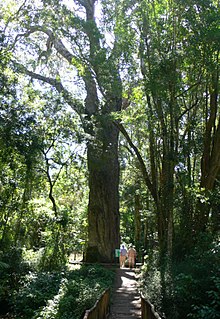Afrocarpus falcatus
| Afrocarpus falcatus | |
|---|---|

| |
| The Big Tree, a specimen in Garden Route National Park | |
| Scientific classification | |
| Kingdom: | Plantae |
| Clade: | Tracheophytes |
| Division: | Pinophyta |
| Class: | Pinopsida |
| Order: | Pinales |
| Family: | Podocarpaceae |
| Genus: | Afrocarpus |
| Species: | A. falcatus
|
| Binomial name | |
| Afrocarpus falcatus | |
| Synonyms | |
|
Afrocarpus gaussenii | |
Afrocarpus falcatus is a tree in the family Podocarpaceae. Common terms include common yellowwood, bastard yellowwood, outeniqua yellowwood, African fern pine, and weeping yew.
The tree is native to the montane forests of southern Africa. It can be found in Malawi, Mozambique, South Africa, and Swaziland. The tree is widespread in some areas and not considered threatened.[1] In South Africa it is a protected tree in South Africa.
Description[change | change source]
This is an evergreen conifer. It often grows up to about 45 meters tall, but is known to reach 60 m. The trunk can be 2 to 3 m wide, and is gray-brown to reddish. The leaves are arranged in spirals on the branches. They are small and narrow, up to 4.5 cm long by about 6 mm wide.
Biology[change | change source]
Female trees bear their fruit only every few years. The main agents of seed dispersal are fruit bats. They eat the fleshy covering but discard the hard, woody seed.
Many birds feed on the fruits, such as hornbills, Cape parrot, purple-crested turaco, Knysna turaco, Ross's turaco, African olive pigeon, African green pigeon, and eastern bronze-naped pigeon. Colobus monkeys, bushpigs and rodents also feed on the fruits.
References[change | change source]
- ↑ "Afrocarpus falcatus". IUCN Red List. Retrieved 21 November 2016.

